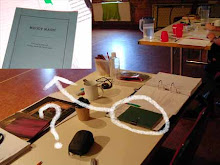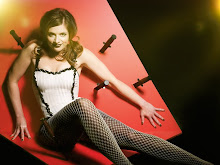The day starts with magic. Obviously I'm not at liberty to divulge any of that, so I headed down and spoke to Richard Vabre, the lighting designer. We were emailed a question in the week from Ian. It reads;
"Given that lighting technologies were far less advanced in Vaudeville days than they are today, how is the time period affecting the lighting design, if at all?"
This is Richard's reply.
When I get back to the rehearsal room. Jim and Chris work on some non-speaking bits. It's a scene focused on busy-ness. Chris thumps the floor at a fast pace to emphasize the pace at which Jim needs to move. He's banging the floor so hard that I could hear him down in the foyer. There was a slight jump in the rhythm which I now realise was Chris changing hands.
At the same time Stephen takes Christen to another room to do what Christen calls “remedial comedy classes.” They've both got a great ear for comedy, and the detailing they come back with is good stuff.
Chris moves onto some of the more important scenes to the central relationships. It will be interesting over the next few days to what Chris spends the majority of his time with. Whether it reveals what scenes the director sees as at the heart of the piece?
Richard, Jethro and Jonathon are all working extremely hard at the moment. The design element on this show across all levels is tremendously well developed, and generates a huge volume of work for everybody on the design team. That reminds me that I've got to get down to Wardrobe again to see how Amanda and Kate are getting on with the costumes.
The company prepares for a run in the afternoon. They are running the entire show. This is the first serious run of the whole show beginning to end. There's a little tension in the air, but nothing like last week.
When it's over it feels to me like a 'whole' for the first time. But what does Chris say?
He thinks it's taken a big step on from Friday, especially Act Two. Act One was a little bitsy, but to be expected since they've been concentrating so much on Act Two. He talks about the action between scenes in Act One, and the upstage action. Transitions are a big job at this stage of just about any process.
He thinks that Act Two is starting to work well. He says that the scenes they haven't touched on for a time that are the weakest, which is both predicable and reassuring. He also talks about how Act Two works from state to state. Again, a transition and rhythmic thing.
There's a bit of discussion about the set. Now that it's being built in the theatre there are some realisations occurring for everybody about how the set is going to work. They talk about some of the potentials they may be able to work with once they get in the space.
It's an issue in making professional theatre that is very hard to solve; how the actors can fully inhabit their world when they often don't get to work within it properly until production week. As we saw in the video last week, the rehearsal room is well kitted out with a genuinely impressive approximation of the set. Even so, it still doesn't feel the same as the theatre, or sound like it. And there are lots of minute physical details of the environment that will be different. Often it is these details that fire the actors' imaginations, and define the world. The way the performers engage with the set is the difference between it being perceived as a 'world' or a 'backdrop.'
Maryanne watched the run again this afternoon and took some more notes. My discussion with her the other day was more wide ranging than the couple of minutes of video. What a dramaturge does can be a bit of a mysterious art at times. But, it's worth relating some more of the conversation because it's interesting relative to how work is developed by theatre companies more generally.
Maryanne mentioned that dramaturgy is often thought of as primarily script work. She sees the role quite differently. She is very much focused on the whole; the physical images, the sound, the juxtaposition of elements, the actors' interpretations of moments, the character arcs, and really everything that comprises the production.
She talks about feeling the energy of the room, understanding where the actors are at in the process, how certain people watching the rehearsal might influence the particular run. Also, the need to feel what the director and writer are going for, and contribute within that frame. She needs to provide a fresh eye and an objective eye, but place herself in the frame of what the creatives are working towards, (which is possibly not at all an objective or readily understandable place.)
Time, time, time. Yes, the run confirmed that development is tracking well. But the countdown clock up top of this blog ticks on. Is there enough rehearsal time before the play opens to audiences? Just three more days in the rehearsal room, then we're in the theatre. That's when the pressure will really start to rise!
Tomorrow, something a little different - a second-by-second run down of an hour in the Vaudeville rehearsal room. Don't miss it!!
Darren word for the day – charred
Chris one word for the day – marathon
Subscribe to:
Post Comments (Atom)




No comments:
Post a Comment